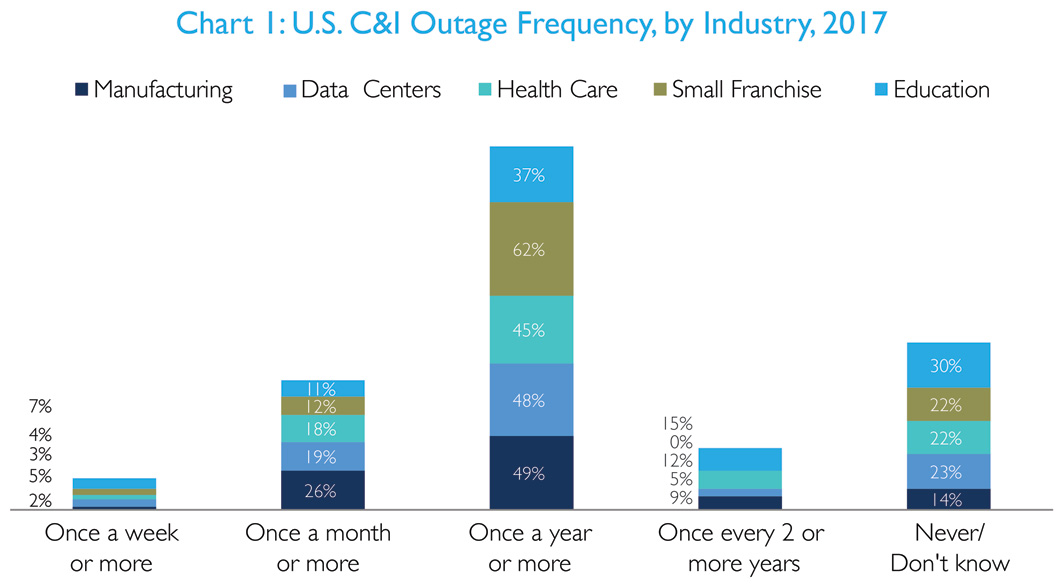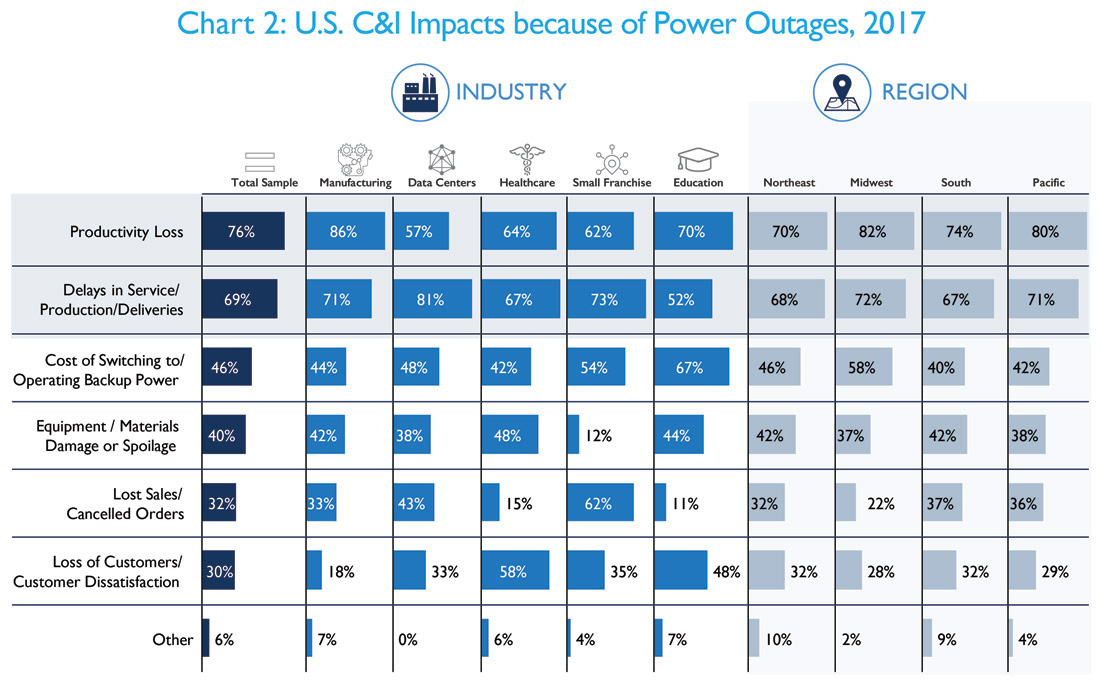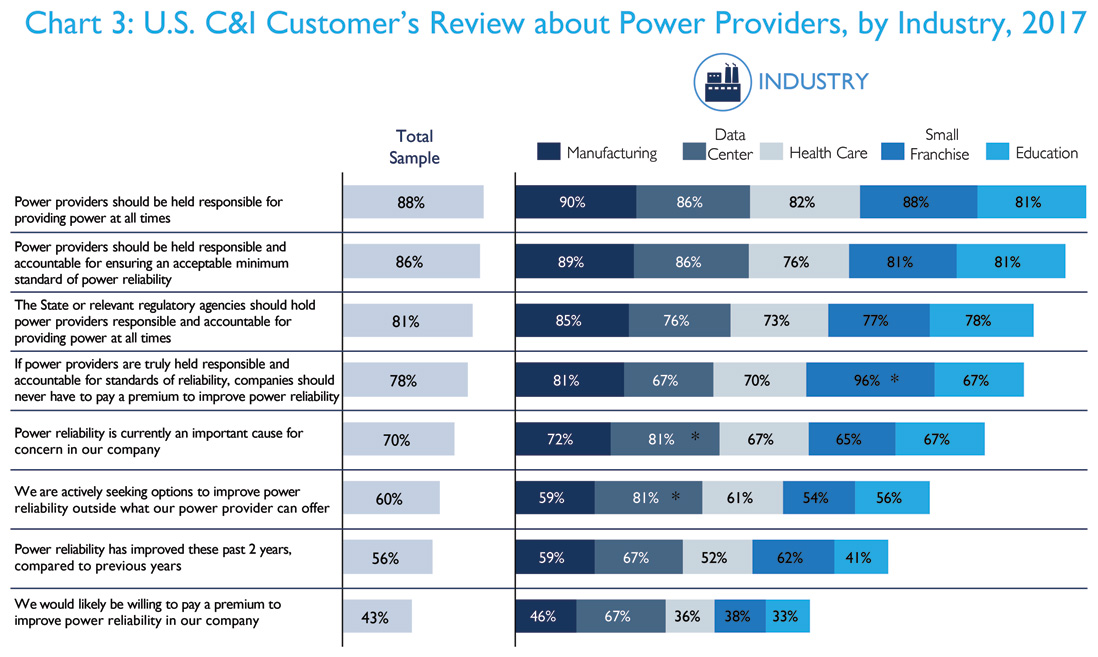Reliability is sort of like an onion in that it has one over¬arching concept with many layers. Energy professionals are bombarded with thousands of “reliability” messages every day: industry indexes, customer-satisfaction reports, and even public-policy debates that also include resiliency in the discussion. It’s no wonder they often define reliability differently.
To cut through the noise, a global provider of equipment and services for electric power systems reached out directly to those that purchase power – utility customers. More specifically, these were Commercial & Industrial (C&I) customers who rely on electricity to provide their products or services and would be in the responsible position to act on their own to find reliable alternatives if there were service gaps.
For its research, the company partnered with Frost and Sullivan to publish the first “State of Commercial & Industrial Power Reliability” report. C&I facilities and energy managers were surveyed across the United States to gather their perspectives on power reliability and their future energy needs.
The respondents’ companies average $4 billion in revenue and make up the majority of metered income for the utilities serving them. If the grid isn’t working for them, the company believed it’s important the industry understands their needs to help shape the grid of the future.
They sorted the respondents into five major sectors: Manufacturing, Data Centers, Healthcare, Small Franchise, and Education. With more than 250 respondents, they had a statistically significant sample that accurately portrayed the industry’s current conditions.
First, they looked to gauge the current experiences C&I customers have with power reliability. Nearly half of those surveyed experienced an outage at least once a year, with another 21 percent experiencing an outage at least once a month. When it came to duration, more than a quarter of participants said their outages lasted more than an hour. Another 41 percent experienced outages between five and 59 minutes. Further results can be seen in Chart 1.
An interesting takeaway was the frequency of outages. When average power users are at home, everyone tolerates outages differently. But most users would logically expect the industrial and medical complexes up the road from to have better service than their residential neighbors. For hospitals, for example, lives could depend on it.
Many of the C&I customers surveyed were typically in locations on the grid that result in better power service than the average residential area. Knowing this, experiencing an outage per month is interesting because one would expect these companies to be on a higher hierarchy of energy service.

CHART 1
U.S. C&I OUTRAGE FREQUENCY, BY INDUSTRY, 2017
(click to enlarge)
As part of its research, the company also looked deeper into each participant’s worst outage. Most of the worst outages these C&I customers experienced lasted an hour or more. Power outages affect business in many ways, and most involve unplanned expenses or other costs. Our survey found that 18 percent of C&I customers experienced a financial impact of $100,000 or more from their worst power outage in 2017, and 19 percent sustained costs of $50,000 or more.
While the survey report does not directly correlate costs to cause, typically, financial loss fell in line with other study results. Not every C&I customer surveyed reported a financial loss caused by an outage, but facilities can, and should, use this information to help justify action to limit future outages.
To this point, all the results could be verified and proven against utility records, but the company wanted to understand more of the frustration and satisfaction that the participants felt with their power provider’s reliability.
When asked, 52 percent of respondents stated they were not fully satisfied with their power provider’s reliability. This suggests respondents hold greater expectations for their providers. While Healthcare experienced significantly fewer and shorter outages than did other segments, the sector led the pack in dissatisfaction. This brings us back to those reliability anecdotes we have all heard. If a midsize manufacturer loses power, it will likely result in a significant cost and potential delays in productivity.
Further, the survey uncovered C&I customers’ thoughts on key areas of improvement for their power providers in terms of reliability. Overwhelmingly, respondents said they would like their power providers to have a long-term view: greater reliability in poor weather, increased use of smart automation, lower prices, increased renewable generation, and an improved ability to address and fix problems quicker than the current standard dictates.
As C&I customers plan for future growth, they seek long-term partnerships with their power providers, and this requires their provider to grow with them and adapt to meet their power demands. Indeed, C&I customers have plans for long-term success, so they value power providers having clear, long-term strategies to update their infrastructure to address customer needs. As a result, when power providers invest in grid hardening and modernization, they are simultaneously solidifying customer retention and improving satisfaction.
On the flip side, the most common reason for C&I customer dissatisfaction with their energy provider was the financial impact to the business. Following that, the common rationale for dissatisfaction with reliability was too many outages with unpredictable timing. Storms aside, these customers require a high level of reliability to continue operations within their business.

CHART 2
U.S. C&I IMPACTS BECAUSE OF THE POWER OUTAGES, 2017
(click to enlarge)
As noted earlier, C&I customers often face a financial impact stemming from each outage they experience, but that cost comes in many different forms. And it’s not just loss of productivity or delays in shipping. If a C&I customer has back-up power, a cost is associated with moving from grid power to back-up power.
As every business can confirm, customer satisfaction is incredibly important. But when the lights go out, that satisfaction, especially in the Healthcare and Education sectors, is greatly affected. Additional impacts can be seen in Chart 2.
The results clearly show C&I customers are looking for improvements from their power providers, but some have taken increasing power reliability into their own hands. While most respondents believe power providers should be held responsible for providing reliable power, without interruption, more than half indicated a willingness to seek options to improve power reliability outside of what their current power provider offers, as shown in Chart 3.
Data Centers may be an obvious example, but they represent a good cross-check of the survey results. Data Center operators have long held that reliable power is a major requirement for their business model, and they often have held a belief that procuring their own power solutions is the best way to guarantee the reliability they require. Ironically, despite most respondents indicating they don’t want to pay premiums for their power, many have funds allocated for guaranteeing their power reliability on their own.
Nearly a quarter of respondents spend $50,000 or more per year on improving their power reliability, independent from their power provider. While they don’t want to pay a premium, that they are willing to allocate these funds suggests power reliability is a true priority concern for their businesses.
Knowing so many C&I customers value their reliability, it’s not surprising 35 percent of respondents indicated they own their own alternative energy sources, such as on-site generation, or battery energy storage systems. Another 25 percent indicated they own these solutions and plan to expand on them to continue to meet their needs.
Not surprisingly, Data Center respondents on average, 57 percent said they own alternative energy sources, and 43 percent said they plan to expand on those solutions. But it is interesting to see majorities in other sectors trending towards the data center and health care sectors when it comes to proactive reliability strategies.
Should the local utility offer premium power? When asked, 62 percent of respondents said yes. But what is premium power?

CHART 3
U.S. C&I CUSTOMER’S REVIEW ABOUT POWER PROVIDERS, BY INDUSTRY, 2017
(click to enlarge)
- 72 percent of respondents agreed or somewhat agreed the bar for reliability should be raised to include loss of generation.
- 67 percent of respondents agreed or somewhat agreed the bar for reliability should be raised to include major weather events.
- 67 percent of respondents agreed or somewhat agreed the bar for reliability should be raised to include outages lasting less than five minutes, and 80 percent of those respondents agreed the bar should be raised further to include outages lasting less than one minute.
Why should the bar be raised? When asked, customers explained that outages are simply too disruptive and costly to their business, in line with earlier findings. The costs these customers incur from outages are large and growing.
Overall conclusions from the survey results point out that, although most C&I customers initially claimed to be content with their power reliability, their behaviors and concerns indicated otherwise–exposing that power reliability is a concern for their business. More importantly, 71 percent of the respondents own, or plan to develop, alternative energy sources to supplement their existing provider.
The study also uncovered that customer satisfaction is the acceptance of the status quo, when in reality, C&I customers need services with higher performance and future-proofing technologies.
Reliability demands aren’t going away. In fact, they will likely increase as load complexity also rises. Today’s grid can no longer meet our demand and reliability needs. With C&I customers voicing their concern, this may be the catalyst for change our grid so desperately needs.
 Jerry Yakel is the director of grid reliability at S&C Electric Company. A tenured commercial leader with broad experience in product management, strategy development, pricing, marketing communications and field sales, his passions are for people and power-system applications. Before joining S&C, Yakel held various leadership roles at Cooper Power Systems, including having global responsibility over various products that included both overvoltage and overcurrent equipment.
Jerry Yakel is the director of grid reliability at S&C Electric Company. A tenured commercial leader with broad experience in product management, strategy development, pricing, marketing communications and field sales, his passions are for people and power-system applications. Before joining S&C, Yakel held various leadership roles at Cooper Power Systems, including having global responsibility over various products that included both overvoltage and overcurrent equipment.
Full results from this report can be found at www.sand.com/CI.







